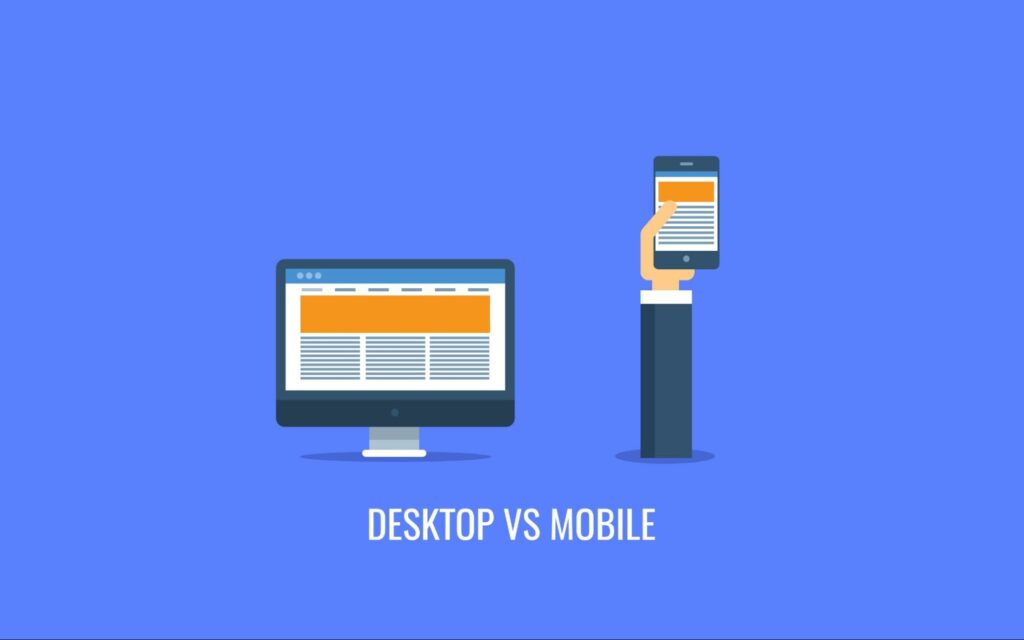The Difference Between Converting Mobile & Desktop Users

As a marketer, you’ve got it drilled into your head that you should optimize for mobile conversion rates as most of the web users are on mobile. But does this make sense when it comes to buying high converting traffic? You should be optimizing your display ads based on what your users do and what the stats say.
Let’s go through the stats of mobile vs desktop conversion rates and explain how you can use this data to take your crypto marketing campaign to the next level.
Mobile traffic stats are higher
According to various studies, mobile is the king of the castle when it comes to web traffic. More than 65% of all web traffic is mobile traffic, meaning that if your goal is simply to get eyeballs on your website, then you need to focus on mobile advertising. On the other hand, desktop users account for around 33% of all traffic on the internet.
Resultantly, with usage shooting up amongst all demographics, mobile marketing statistics become more vital for digital markers. Today, more than half of all web traffic is mobile.

Interestingly, this trend is set to continue, with the Ericsson Mobility Report smartphone analytics predicting a 25% increase in mobile traffic by 2025. Much of this traffic will come from increased video and streaming on mobile devices.

If you value crypto mobile traffic over desktop, then this is a powerful stat. But it’s worth noting that mobile conversion is a lot smaller, leading to the debate; which should I focus on? Mobile vs desktop crypto traffic?
A little bit statistics
- Over the course of one year, mobile users’ share increased by over 10%.
- Mobile vs desktop usage stats in 2021 reveal 50% B2B inquiries were made on mobile last year.
- Social media covers 25% of all digital media consumption and it is mainly accessed on mobile.
- In 2020, US adults spent 4 hours per day browsing on their mobile phones.
- In 2021, mobile phones generated 54.25% of traffic, whilst desktop users accounted for 42.9%.
- 55% of page views in 2021 come from mobile phones.
- Phone-based CPC costs 24% less than desktop and carry a 40% higher CTR.
- Mobile apps have higher engagement rates than mobile-optimized websites and desktop web viewing.
Desktop takes the lead for conversion rate
Despite seeing a smaller portion of the global traffic, desktop users convert better. According to SaleCycle, mobile users convert at a rate of 1.81%, while desktop users convert at a rate of 1.98%. Interestingly, it’s tablet users that convert the best, with a conversion rate of 2.92%. This is down to greater confidence attached to using a bigger screen. The larger it is, the less risk there is for a user to click on something that he/she never intended to click on in the first place.
The stats do change slightly based on the item or service that is being paid for. When the purchase is more complicated or expensive, the desktop improves its conversion rate.

The path to conversion on mobile is not the same
The mobile purchasing process is often different compared to desktop. Forms and fields feel like they take longer to fill in owing to the smaller screen size and the small keyboard size. Mobile users vs desktop users are also more likely to be browsing at an inopportune moment. They could have been flicking through social media, seen an advert and added an item to the cart. But then owing to the fact that mobile sessions are shorter on average, the session comes to an end and the user is lost.
On the other hand, desktop users are more invested in their browsing session and are therefore more likely to lead to a conversion. Desktop users also have access to more information, such as credit cards, banking details and other information that might be stored in a secure location, rather than in the memory of a mobile phone.
Focus on desktop users for maximum conversions
When you’re creating your crypto ad campaign, you have to bear these figures and stats in mind. If you’re going to boost your conversion rate and optimize it, using a platform that allows you to upload specific mobile and desktop ads is critical. Showing crypto ads to people over and over again creates brand familiarity, so it’s important to show ads to both mobile and desktop users. Just be sure to focus the majority of your campaign towards the desktop users, as these users will be the highest converting data set.
With Bitmedia’s powerful targeting tools, you can refine your target audience and device types based on numerous data points, meaning that the conversion rate for your display ads will be as optimized as it possibly can be. By targeting particular geos at particular times of the day, you can fine tune the amount of exposure your brand gets, helping create that all important brand awareness.
Key differences between converting mobile and desktop users
- User behavior: Mobile users tend to have shorter attention spans and are often looking for quick solutions to their problems. They are also more likely to be multitasking or on-the-go, which means they may not have the same level of focus as desktop users. Desktop users, on the other hand, may have more time and be more willing to engage with longer content or take more complex actions.
- User experience: The user experience on mobile devices is different than on desktop computers. Mobile screens are smaller, touch-based, and require more scrolling and tapping. Desktop screens are larger, mouse-based, and allow for more multi-tasking. To optimize for conversions, it’s important to ensure that the user experience is seamless and intuitive on both mobile and desktop devices.
- Technical limitations: Mobile devices may have technical limitations that can affect the user experience and ability to convert. For example, slow internet speeds, limited storage space, or older devices may impact how quickly pages load or how well the website or app functions. Desktop users, on the other hand, are generally not limited by these technical constraints.
- Search behavior: Mobile users are more likely to use voice search or location-based search to find what they’re looking for. Desktop users may be more likely to use traditional search engines or other online resources. It’s important to understand how your target audience searches for information and optimize your content accordingly.
- Design considerations: Design is critical for optimizing conversions on both mobile and desktop devices. However, the design considerations may differ depending on the platform. For example, mobile devices require simpler and more streamlined designs to account for smaller screens, while desktop designs may have more flexibility and opportunities for customization.
The conclusion
Desktop users are worth their weight in gold. They convert better and they will cost you less to advertise to. Your spend will go further owing to the fact that there are less desktop users around. This gives you the leverage to enhance your conversion rate. But don’t discount mobile users that are using desktop mobile. These users can skew the results slightly, but with a well optimized campaign it will not be an issue.
By setting your crypto campaign budget spend to cater more towards brand awareness on mobile and direct conversions on desktop, you’ll take your conversion rate to the next level!
Get your ad campaign started
If you want to take your bitcoin ads conversion rate to the next level, take full advantage of Bitmedia’s crypto display ad network. You have access to unparalleled tools, giving you the resources that you need to maximize conversions.
Reach out to the Bitmedia team today and get your high converting display ad campaign underway!
Get crypto traffic

